Please read prior to installation and have proper equipment and safety precautions in place.
For additional information please visit our website at www.soilretention.com or call 800-346-7995.
Installer Qualifications: An experienced installer and who has successfully completed installations of pavers, porcelain pavers, or other pavement systems on projects of similar or larger scope and magnitude is recommended. Please note that Drivable Grass (1.5” thick) has a thinner profile than pavers and while having similar installation procedures to pavers there are critical differences.
Planning: Final surface elevations and tolerances should be as specified on the project plans. Special consideration should be given to layout, pattern, slope, drainage, root barriers and edging/confinement.
1. Drivable Grass® Material Specification
- Permeable, Flexible, Plantable Pavement System:
- Nominal Dimensions in inches (l x w x h) :
- Gross Area:
- Weight:
- Compressive Strength:
- Drivable Grass® mats per pallet (each):
- Area Covered per Pallet:
- Color:
- Flexibility (minimum radius of curvature in inches):
Drivable Grass®
24 in. x 24 in. x 1.5 in.
4 SF
45 lbs.
8,000 psi
60
240 S.
Natural Grey (Earl Grey and Shilo Tan)*
12
*Earl Grey and Shilo Tan are manufactured only in CA. Custom colors available upon request for job lot quantities.
2. Drivable Turf® Material Specification
- Pre-cut Artificial Turf:
- Nominal Dimensions in inches (l x w) :
- Gross Area:
- Drivable Turf® pieces ber box (each):
- Area Covered per Box:
- Color:
Drivable Turf®
4 ft. x 4 ft.
16 SF
20
320 SF
Green w/Brown Thatch
3. Main Steps of the Installation
- Subgrade Preparation/Subsurface Drainage (if required)
- Perimeter Confinement
- Geotextile Installation (if required)
- Base Material Installation
- Compaction
- Bedding Installation
- Screeding
- Drivable Grass® Mat Placement
- Spike Installation
- Sand Infill for Joints
- Drivable Turf® Installation
- Sand Infill
A. Subgrade Preparation/Subsurface Drainage (if required)
Excavate the installation area to the proper depth to allow for the structural pavement section below the Drivable Grass® installation in accordance with project plans and specifications. Complete any additional over-excavation and re-compaction as required to provide a firm and unyielding subgrade.
Where permeability of the subgrade is important, and site conditions permit excavation into strong native soils, compaction of the subgrade may be minimized to trimming.
Test and approve the subgrade condition and provide written certification confirming the preparation, density and elevations conform to the project plans and specifications. Special consideration should be given for the following conditions:
- Over-excavation depths and re-compaction of subgrade
- Application of geotexile fabric over prepared subgrade (if required)
- Sub-surface drainage due to low permeable subgrade (if required)
B. Perimeter Confinement
Keeping the edges of the Drivable Grass® installation contained is crucial for a successful long-term installation.
- All driving applications require a concrete mow-strip or existing concrete at edge conditions that will see vehicular access.
- Other edging materials, such as steel or complimenting pavers, can be used in other areas where the edge is not subject to vehicular access. Using pavers as confinement can limit cuts of the Drivable Grass® mats.
C. Geotextile Installation (if required)
Geotextile type should be in accordance with project plans and specifications. At a minimum, the geotextile should be placed at the bottom and sides of the sub-grade and secured in place to prevent wrinkling. Overlap at the seams of the geotextile should be a minimum of 12 inches.
NOTE: Geotextile is always required for clay soils.
D. Base Material Installation
Backfill, level, and compact the required base material to the density, depth/thickness and surface elevation in accordance with the project plans and specifications.
NOTE: A proper aggregate base will contain a gradation of particles that will pack tightly together.
Local, state or provincial standards for aggregate base materials for roads should be used for the gradation and quality of dense-graded aggregate base materials. If no standards exist, follow ASTM D 2940, Standard Specification for Graded Aggregate Material for Bases or Subbases for Highways or Airports. The gradation for base material from this standard is given in the table below. This material should be compacted to a minimum of 95% Standard Proctor density per ASTM D 698 or local standards.
| ASTM D 2940: Gradation for Dense-Graded, Crushed Stone Base | |
| Sieve Size | Percent Passing |
| 2 in. | 100 |
| 1 1/2 in. | 95 to 100 |
| 3/4 in. | 70 to 92 |
| 3/8 in. | 50 to 70 |
| No. 4 | 35 to 55 |
| No. 30 | 12 to 25 |
| No. 200 | 0 to 8 |
Where a permeability rate and/or water storage is required, a permeable base material that allows compaction and packs together is required for the initial 8 inches. This material generally has no more than 3 % fines passing the No. 200 sieve. In CA an example of this material is Caltrans Class 2 Permeable.
| Gradation for Caltrans Class 2 Permeable Material | |
| Sieve Size | Percent Passing |
| 1 in. | 100 |
| 3/4 in. | 90 to 100 |
| 3/8 in. | 40 to 100 |
| No. 4 | 25 to 40 |
| No. 8 | 18 to 33 |
| No. 30 | 5 to 15 |
| No. 50 | 0 to 7 |
| No. 200 | 0 to 3 |
Below the initial 8” permeable layer of permeable material, a geotextile can be used on top of an open graded rock for additional water storage.
NOTE: Open graded rocks (#8, #57, etc.) commonly used with Permeable Interlocking Pavements shall not be used in the top 8 inches due to limited sidewall of mats.
E. Compaction Process
To achieve good compaction, use the type of machine that provides the proper force, amplitude, and frequency. Continue to add and compact base material until the top of the base is approximately 2 in. below the final height of the finished elevation. The remaining space is for the 0.5 in. of sand bedding and the 1.5 in.-thick Drivable Grass® mats.
Establish final height by setting string lines to final elevation. The elevation between the material base and the final elevation should be uniform.
Note: The recommended base surface tolerance should be (+/-) 1/4 in. over a 10 ft. straight edge.
F. Bedding Installation
A minimum uniform bedding thickness of 1/2 inch should be used for non-planted installations.
Bedding should consist of clean, non-plastic, sand that is free from deleterious or foreign matter. The sand shall be sharp and manufactured from crushed rock. Do not use limestone screenings or stone dust. The particles shall conform to the grading requirements given in the table below:
|
ASTM C33 CSA A23.1-M94 |
|
| Sieve Size | Percent Passing |
| 3/8 in. | 100 |
| No. 4 | 95 to 100 |
| No. 8 | 85 to 100 |
| No. 16 | 50 to 85 |
| No. 30 | 25 to 60 |
| No. 50 | 0 to 30 |
| No. 100 | 2 to 10 |
NOTE: It is important to moisten, but do not saturate sand bedding prior to installation.
table below:
G. Screeding
Spread moist sand uniformly and screed. Use steel pipes, edge restraints and string lines to assure the screeded sand will allow the top of the and Drivable Grass® mats to conform to designed finished elevations. Allow 1/8 in. to 1/4 in. above specified surface elevations to compensate for minor settlement.
Note: For Class 2 permeable or equal bases that have voids at the surface, we recommend compacting the bedding layer to ensure the sand settles into the larger voids at the surface of the base.
H. Drivable Grass® Mat Placement
Install the Drivable Grass® mats in a running bond pattern. Working in one axial direction at a time, securely butt mats up against each other. Trying to install Drivable Grass® in more than one axis at a time could result in a significant alignment problem. We recommend a diagonal string line or large 90 degree angle to help with alignment. Make sure to check the alignment in both directions. Make minor adjustments to Drivable Grass® mats as required to maintain good grid pattern alignment.
Partial mats will be necessary. Fit the area first to avoid ending up with small pieces of the individual pieces that would likely come lose. Do not drag the Drivable Grass® mats or walk on sand bedding as this can cause uneven placement.
The grid inside the Drivable Grass® mats can be cut with a utility knife or chisel to fit site conditions. At terminating edges or curved installations, the mats can also be cut with a masonry blade and using a powdered chalk line. Be sure to properly clean the Drivable Grass® mats after cutting with a dry blade by brushing or blowing to avoid staining from fine dust.
Partial mats (minimum of 2 X 2 muffins) should be limited to edges where driving is limited. Make sure to make minor adjustments to fit large pieces leaving no significant gaps between the edge restraint and the mats. Secure partial mats using 8 in. spikes in at least two locations. Cut installed full mats as needed along edges to fit a minimum of 2 X 2 muffins.
- Seat the Drivable Grass® mats into the bedding course prior to installing any spikes, using a low-amplitude, 75-90 Hz vibrating plate compactor. This will also help get the bedding sand up in the joints between the mats. Use a fabric or pad between the compactor and Drivable Grass® mats to prevent scuffing or chipping.
- Final surface tolerances should be as follows:
- Final surface tolerance of Drivable Grass® mats shall not deviate more than (+/-) 1/4 in. over a 10-foot straight edge.
- Surface elevation of the Drivable Grass® mats shall be 1/8 in. to 1/4 in. above adjacent drainage inlets, concrete collars or other type of inlets.
- Lippage: No greater than 1/8 in. difference in height between Drivable Grass® mats.
I. Spike Installation (recommended for vehicular driving installations)
Required Tools:
- Air Compressor: 5 CFM at 90 psi (min)
- Air Hose Size: 3/8 in. diameter (min)
- Soil Retention Installation Kit (see Photo 1)
-
- Soil Retention Hammer Rod
- Soil Retention Nail Guide
- Air Hammer: 3 CFM at 90 PSI, Stroke length 1.5 in.
- Oil (for Air Hammer)
Note: Frequently check the oil level of the air hammer. Refill oil level as necessary with the oil provided. Operating the air hammer without oil will result in significant damage.
-
- 8 in. Galvanized Spikes: 2 per mat (spiral spikes recommended for hard / large aggregate penetrations)
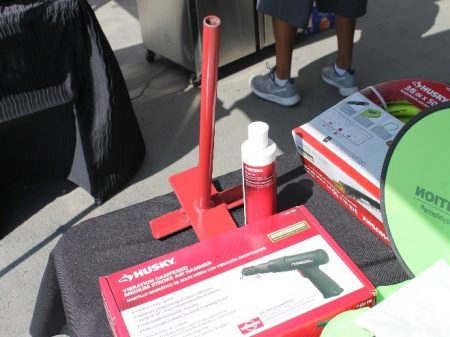
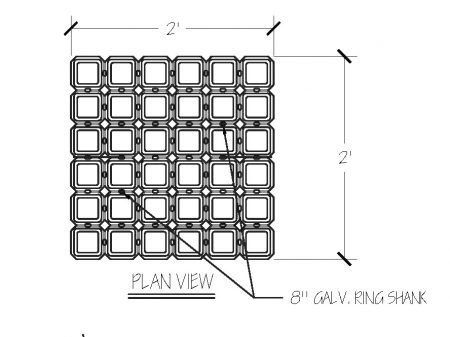
Spike Installation Sequence:
-
- Place the 8 in. galvanized spikes in two locations (see Photo 2).
- Using a hammer, set the 8 in. galvanized spikes in place prior to using the air hammer.
- Place the nail guide over the 8 in. galvanized spike.
- Using the hammer rod and air hammer, drive the 8 in. spikes to the base of the Drivable Grass® mat (see Photo 3). Do not keep driving the spikes after the end of the hammer rod has reached the base of the nail guide as this may cause damage to the Drivable Grass® mats.
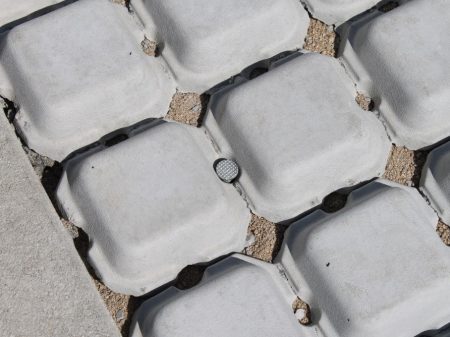
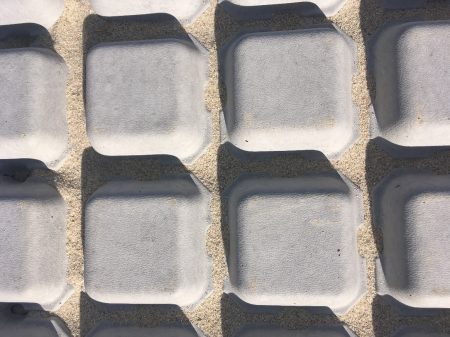
J. Sand Infill for Joints
Required Items and Tools:
- Sand (#30 industrial sand)
- Drop Spreader
- Blower
Use a drop spreader and blower, to fill sand to the top of the Drivable Grass® mat base (see Photo 4).
K. Drivable Turf® Installation
Required Items and Tools:
- Polyurethane Adhesive, i.e. Use 1 oz/sq ft for planning purposes.
- 28 oz. SRW Products – Rapid-Set Polyurethane (more working time)
- 28 oz. Gator Block Bond – XP Xtra Performance Adhesive, or
- Caulking Gun (electric and / or drip free recommended)
- Push Broom
- Blower
- Utility Knife
- ¾” Caulking Trowel
- Power Brush (optional)
- ½ inch heavy sled brick jointer (recommended: OX-P030312) or ¾” wide x 2” diameter or greater wheel
Pre-Drivable Turf® Installation Preparation
- Clean area of any debris with blower prior to Drivable Turf®
- Pre-fit the Drivable Turf® over the Drivable Grass® Lay backing facing up flat in sunlight to get any memory out of the plastic. Pay special attention to the orientation of the Drivable Turf® to assure the grass blades and designed edge pattern (fingers) go in the same direction (see Photo 5).
- Make necessary clean cuts with a utility knife or commercial quality scissors to fit the area. Edge terminations may require the Drivable Turf® to be cut to avoid bulging (see Photo 6).
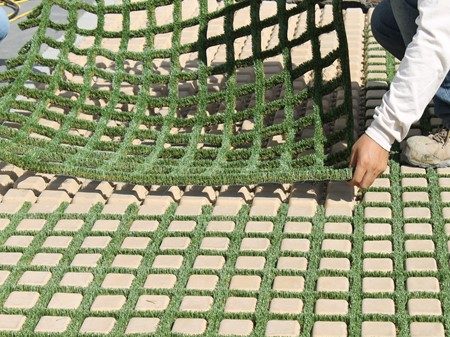
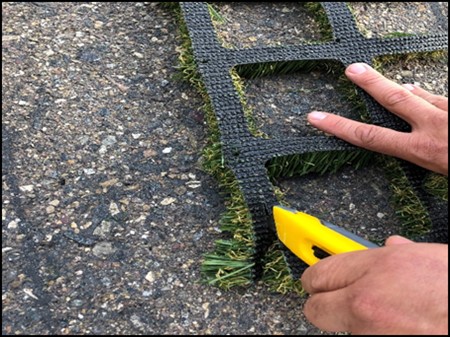
Adhesive Application and Drivable Turf® Placement
Be sure to read the adhesive instructions paying close attention to the working time, cure time and outside temperature. A test application prior to the turf installation, to confirm bead size and when the adhesive becomes tacky for bonding, is recommended. We recommend working with one piece of turf at a time to make sure you have enough adhesive at the edges and at the loose ends of the turf.
- Clean surface with a blower from any sand, debris, or loose fibers before application of adhesive.
- Apply ¼ in. Dia. Polyurethane Adhesive bead size to the contact area for the Drivable Turf®. Below are two options:
Option 1: Apply around each muffin (Photo 7)
Option 2: Apply in a Criss-Cross pattern. A ¾ in. caulking trowel can be used to spread the adhesive evenly across the contact area for the turf. (Photo 8)
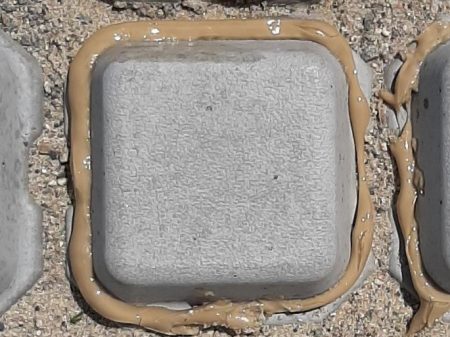
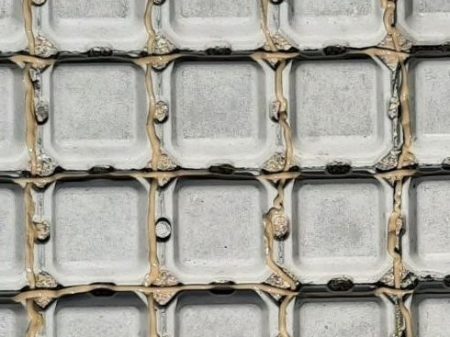
-
- Lay the Drivable Turf® over the Drivable Grass® mats and firmly press into position using a ¾ inch wide x 3 inch diameter wheel (see Photo 9). a ½ inch heavy sled brick jointer (recommended: OX-P030312) (see Photo 10)
- Make sure the adhesive has made a good bond between the concrete and turf. This can be coordinated with your test application for the right time to adhere.
- Let adhesive cure before next step (refer to adhesive manufacturer’s recommendation for cure times).
Note: Applying too much adhesive and not pressing it down will elevate the turf too high and vehicular driving will damage the turf. Applying too little adhesive will result in not having a good enough bond to apply the turf infill without getting under the turf. Adhesive should be pressed down to no more than 1/16” above concrete surface.
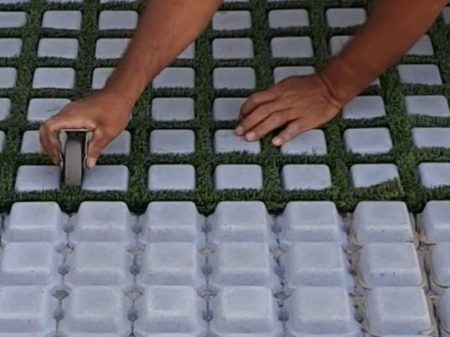
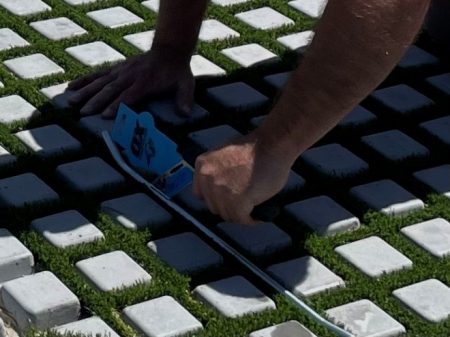
L. Sand Infill
Sand Infill up to ¼” below surface is recommended for public spaces and areas exposed to foot traffic. The Drivable Turf® is tightly stitched, similar to putting green turf, so we recommend #30 industrial sand for the first ½” of infill in order to penetrate into the turf and create a firm joint. Larger colored particle sand infill can be used on top of the #30 sand after the initial ½” of #30 industrial sand. One cubic foot of sand will cover approximately 40 square feet.
-
- Apply sand infill evenly using a drop spreader.
- Broom sand in both directions
- Water down the area with a hose to settle the sand.
- Repeat steps a – c until you have achieved the right fill height with the infill sand about ¼” below the concrete surface.
- Power Brush finish is optional







